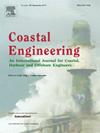Slamming loads induced by dam-break flow on land-based oscillating water columns: Numerical and experimental study
IF 4.2
2区 工程技术
Q1 ENGINEERING, CIVIL
引用次数: 0
Abstract
A 3D Reynolds-Averaged Navier-Stokes (RANS) flow solver with a Volume of Fluid (VOF) surface capturing scheme is used to investigate the dam-break flow induced slamming impacts on land-based oscillating water columns (OWC). Comprehensive experiments are conducted to validate the numerical model. It is found that the compressible RANS-VOF solver more accurately captures the key physical processes in this complex fluid-structure interaction process than the incompressible solver. The complete process of dam-break flow impact on OWCs is analyzed in detail, focusing on the relationship between peak forces, moments, slamming pressures, and fluid behaviors. It is found that the peaked vertical loads due to air pressure on the deck of the OWC chamber are non-negligible, particularly for small opening ratios (<3.5%), which has not been previously reported. Additionally, the air pressure on the deck significantly contributes to the moment of the OWC caisson. The distribution of slamming pressure on the front wall, corresponding to peak loading, resembles that of breaking waves in realistic seas. This implies that dam-break flow tests can be used to capture the fundamental physics behind the strong nonlinear waves interacting with OWCs. Numerical simulations are performed to examine the influence of the opening ratio of the OWC chamber on slamming characteristics. It is found that slamming loads on the OWC decrease rapidly with increasing opening ratio in from 0% to 3.5%. However, when the opening ratio exceeds the critical value of 3.5%, the slamming loads change only slightly. Furthermore, during the slamming process, the air pressure inside the chamber is proportional to the velocity of the water surface inside the chamber.

溃坝水流对陆基振荡水柱的冲击荷载:数值与实验研究
采用基于流体体积(VOF)表面捕获方案的三维reynolds - average Navier-Stokes (RANS)流动求解器,研究了溃坝水流对陆基振荡水柱(OWC)的冲击效应。通过综合实验对数值模型进行了验证。结果表明,可压缩ransv - vof求解器比不可压缩求解器更准确地捕捉了复杂流固耦合过程中的关键物理过程。详细分析了溃坝水流冲击OWCs的全过程,重点分析了峰值力、弯矩、冲击压力与流体特性之间的关系。研究发现,由于OWC室甲板上的空气压力引起的峰值垂直载荷是不可忽略的,特别是对于较小的开度比(<3.5%),这在以前没有报道过。此外,甲板上的空气压力对OWC沉箱的力矩有很大的影响。前壁上的撞击压力分布与峰值荷载相对应,与现实海洋中的破浪分布相似。这意味着溃坝流量试验可以用来捕捉与OWCs相互作用的强非线性波背后的基本物理。通过数值模拟研究了燃烧室开度比对轰击特性的影响。结果表明,随着开度比从0%增加到3.5%,冲击载荷迅速减小。而当开启比超过3.5%临界值时,冲击载荷变化不大。此外,在撞击过程中,舱内的空气压力与舱内水面的速度成正比。
本文章由计算机程序翻译,如有差异,请以英文原文为准。
求助全文
约1分钟内获得全文
求助全文
来源期刊

Coastal Engineering
工程技术-工程:大洋
CiteScore
9.20
自引率
13.60%
发文量
0
审稿时长
3.5 months
期刊介绍:
Coastal Engineering is an international medium for coastal engineers and scientists. Combining practical applications with modern technological and scientific approaches, such as mathematical and numerical modelling, laboratory and field observations and experiments, it publishes fundamental studies as well as case studies on the following aspects of coastal, harbour and offshore engineering: waves, currents and sediment transport; coastal, estuarine and offshore morphology; technical and functional design of coastal and harbour structures; morphological and environmental impact of coastal, harbour and offshore structures.
 求助内容:
求助内容: 应助结果提醒方式:
应助结果提醒方式:


